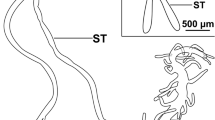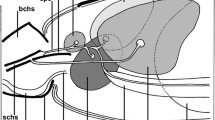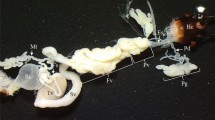Abstract
A study was conducted to determine the morphology, histology and ultrastructure of the salivary apparatus of Lethocerus indicus. The apparatus was found to consist of a principal and accessory salivary gland. The former is bilobed, having a small superior lobe and a larger inferior lobe, made up of many lobules/acini. Each lobule is made up of a simple glandular layer of syncytial epithelium encompassing the lumen, which is filled with secretory granules that are elaborated from the epithelium predominantly by the apocrine mode of secretion. The accessory salivary gland is vesicular cum tubular. The vesicular part is made up of a thin layer of flat, polygonal cells, having no signs of secretory activity, while the tubular part consists of a single layer of columnar epithelial cells that show signs of secretory activity. Both the principal and accessory glands discharge their secretions through a common salivary duct which opens at the base of the hypopharynx. The ultrastructure of the lobules of the principal salivary gland reveals a thick amorphous, basement membrane (800–1000Å) which supports the glandular epithelium. The basal and apical plasma membranes of the epithelium show basal infoldings and microvilli respectively. The nucleus is highly branched and remains surrounded by a double layered nuclear envelope. The ergastoplasmic membranes show abundance of ribosomes. Many mitochondria are also visible in the cytoplasm. It is concluded that the salivary gland of L. indicus is an organ of high synthetic activity.
Résumé
Des investigations sur la structure, l’histologie et la morphologie de l’appareil salivaire de L. indicus révèlent que celui-ci consiste en une glande salivaire principale et une glande salivaire accessoire. La première est bilobée, ayant un petit lobe supérieur et un plus grand lobe inférieur, composé de plusiers lobules/acini. Chaque lobule est composée d’une simple couche glandulaire d’épithélium syncytial enveloppant le lumen et remplie de granules sécrétrices qui sont élaborées en majeure partie par l’épithélium d’après un mode de sécrétion apocrine. La glande salivaire accessoire est du type vésiculaire tout comme tubulaire. La partie vésiculaire est composée d’une mince couche de cellules plates et polygonales ne montrant aucun signe d’activité sécrétrice tandis que la partie tubulaire consiste en une simple couche de cellules épithéliales en forme de colonne et manifestant des signes d’activité sécrétrice. Toutes les 2 glandes, la principale et l’accessoire déchargent leurs sécrétions dans un conduit salivaire commun qui débouche à la base de l’hypopharynx. L’ultrastructure des lobules de la glande salivaire principale revèle une épaisse membrane basale amorphe (800–1000 Å) qui soutient l’épithelium glandulaire. Les membranes de plasma basal et apical de l’épithelium montrent des replis internes basal et des microvilli respectivement. Le noyau est fortement branché et est entouré d’une enveloppe nucléaire à double couche. Les membranes ergastoplasmiques montrent une multitude de ribosomes. Plusieurs mitochondries sont aussi visibles dans le cytoplasme. Toutes ces particularités suggèrent que la glande salivaire de L. indicus est un organe à forte activité synthétique.
Similar content being viewed by others
References
Ameen M. and Abedin N. (1975) Anatomy, histology and secretions of the salivary glands of Sphaerodema rusticum (F) (Hemiptera: Belostomatidae). Int. J. Insect Morphol. Embryol. 4, 35–47.
Baptist B.A. (1941) The morphology and physiology of the salivary glands of Hemiptera-Heteroptera. Q. J. Micros. Sci. 83, 91–139.
Bonhag P.F. (1959) Histological and histochemical studies on the ovary of American cockroach, Periplaneta americana. Univ. California Publ. in Entomology 16, 81–124.
Cioffi M. (1984) Comparative ultrastructure of arthropod transporting epithelia. Amer. Zool., 24, 139–156.
Copeland E. (1964) A mitochondrial pump in the cells of the anal papillae of mosquito larvae. J. Cell Biol. 23, 253–264.
Czolij R. T. and Slaytor M. (1988) Morphology of the salivary glands of Mastotermes darwiniensis Froggatt (Isoptera: Mastotermitidae). Int. J. Insect Morphol. Embryol. 17, 207–220.
Elson J. (1937) A comparative study of Hemiptera. Ann. Entomol. Soc. Amer. 30, 579–597.
Goverdhan T. L., Shyama Sundari K. and Rao K. H. (1982) The salivary glands of Abedus ovatus (Heteroptera: Belostomatidae). Int. J. Entomol. 1, 53–60.
Gupta B. L. and Berridge M. J. (1966) Fine structure organization of the rectum in the blowfly, Calliphora erythrocephala (Meig) with special reference to connective tissue, tracheae and neurosecretory innervation in the rectal papillae. J.Morphol. 120, 23–81.
Haridass E. T. and Ananthakrishnan T. N. (1981) Functional morphology of the salivary system in some Reduvidae (Insecta: Heteroptera). Proc. Indian Acad. Sci. (Anim. Sci.). 90, 145–160.
Hassett C. C. and Jenkins D. W. (1951) The uptake and effect of radiophosphorous in mosquito. Physiol. Zool. 24, 257–266.
Jacob J. and Jurand A. (1963) Electron microscopic studies on salivary gland cells of Bradysia mycorum (Sciaridae) III. The structure of cytoplasm. J. Insect Physiol 9, 849–857.
Jarial M. S. and Scudder G. G. E. (1970) The morphology and ultrastructure of the malpighian tubules and hind gut in Cenocorixa bifida (Hung) (Hemiptera: Corixidae). Z. Morph. Tier 68, 269–299.
Jurand A. and Pavan C. (1975) Ultrastructural aspects of histolytic processes in the salivary gland cells during metamorphic stages in Rhyncosciara hollaenderi (Diptera: Sciaridae). Cell Differ. 4, 219–236.
Kafatos F. C. (1971) Cellular metamorphosis. I. The labial gland of Antheraea pernyi. Endocrin. Experimentalis 5, 101–107.
Karnovsky M.H. (1965) A formaldehyde-glutaraldehyde fixative of high osmolality for use in electron microscopy. J. Cell Biol. 27, 137A–138A.
Klei T. R. and De Giusti D. L. (1973) Ultrastructural changes in salivary glands of Pseudolynchia canadensis (Diptera: Hippoboscidae) infected with sporozoites of Haemoproteus columbae. J. Invert. Pathol. 22, 321–328.
Kloetzel J. and Laufer H. (1970) Developmental changes in fine structure associated with secretion in larval salivary gland of Chironomus. Exp. Cell Res. 60, 327–337.
Knutton S., Jackson D., Graham J.M., Micklem K.J. and Pasternak C.A. (1976) Microvilli and cell swelling. Nature 262, 52–54.
Kumar D. (1978) Histophysiological studies of the salivary apparatus of some Indian Hemiptera. Morphological, histochemical, autoradiographic and electron microscopic investigations. Ph.D. Thesis, Banaras Hindu University, Varanasi, India.
Kumar D., Ray A. and Ramamurty P. S. (1978) Histophysiology of the salivary glands of the red cotton bug, Dysdercus koenigii (Pyrrhocoridae-Heteroptera) histological, histochemical, autoradiographic and electron microscopic studies. Z. Mikrosk. Anat. Forsch. Leipzig. 92, 147–170.
Kumar D., Ray A. and Ramamurty P. S. (1980) Studies on the salivary glands of Lygaeus sp. (Lygaeidae-Heteroptera)—Histological, histochemical, autoradiographic and electron microscopic investigations. Z. Mikrosk. Anat. Forsch. Leipzig. 94, 669–695.
Miles P. W. (1972) The saliva of Hemiptera. In Advances in Insect Physiology (Edited by Treherne J. E., Berridge M. J. and Wigglesworth V. B.), 9, 183–225. Academic Press, London.
Moericke V. and Wohlfarth-Bottermann K. E. (1960) Zur funktionellen Morphologie der Speicheldrusen Von Homopteran. IV. Die Ausfuhvgange der Speicheldrusen Von Myzus persicae (Sulz). Aphididae Z. Zellforsch. 53, 25–49.
Odhiambo T. R., Kokwaro E. D. and Sequeira L. M. (1983) Histochemical and ultrastructural studies on the male accessory reproductive glands and spermatophore of the tsetse, Glossina morsitans morsitans (W.). Insect Sci. Applic. 4, 227–236.
Oschman J. L. and Berridge M. J. (1970) Structural and functional aspects of salivary fluid secretion in Calliphora. Tissue and Cell 2, 281–310.
Phillips J. E. and Meredith J. (1969) Active sodium and chloride transport by anal papillae of a salt water mosquito larva (Aedes campestris). Nature 222, 168–169.
Quayum M. A. (1975) Morphology and secretion of the salivary glands of Ranatra filiformis Fabr. (Heteropetra-Nepidae). Bangaladesh. J. Zool. 3, 49–54.
Rastogi S. (1961) The anatomy of the digestic organs of Sphaerodema rusticum Fabr. (Heteroptera: Belostomatidae). Proc. Rajasthan Acad. Sci. 8, 60–78.
Reynolds E. S. (1963) The use of lead citrate at high pH as an electron opaque stain in electron microscopy. J. Cell Biol. 17, 208–212.
Rilling G. (1966) Die Speicheldrsen der Reblans (Dactylosphaera vitifolli shimer). Vitis. 6, 136–150.
Sohal R. S. and Copeland E. (1966) Ultrastructural variations in the anal papillae of Aedes aegypti (L) at different environmental salinities. J. Insect Physiol 12, 429–439.
Southwood T. R. E. (1955) The morphology of the salivary glands of terrestrial Heteroptera (Geocorisae) and its bearing on classification. Tijdscher. Entomol. 98, 77–84.
Treherne J. E. (1954) The exchange of labelled sodium in the larvae of Aedes aegypti (L.). J. Exp. Biol 31, 386–401.
Witkus E. R., Grillo R. S. and Smith W. J. (1969) Microtubules of the hind gut epithelium in the woodlouse, Oniscus ascellus. Proc. E.M. Soc. Amer. 27, 312–313.
Yadav P. R. (1988) Studies on the salivary apparatus and saliva of some Hemiptera. Ph.D. Thesis, Banaras Hindu University, Varanasi, India.
Yadav P. R. (1990) Morphological, histological and histochemical observations on the salivary glands of Ranatra filiformis Fabr (Heteroptera). J. Zool. Res. 3, 89–99.
Yadav P. R. and Kumar D. (1993) Histochemical analyses of saliva of some predatory bugs (Heteroptera). Asian J. Zool Sci. 2, 5–15.
Author information
Authors and Affiliations
Rights and permissions
About this article
Cite this article
Kumar, D., Yadav, P.R., Venugopal, K.J. et al. Studies on the Salivary Glands of an Aquatic Bug, Lethocerus Indicus (Belostomatidae): Morphological, Histological and Preliminary Electron Microscopic Investigations. Int J Trop Insect Sci 16, 51–61 (1995). https://doi.org/10.1017/S1742758400018324
Accepted:
Published:
Issue Date:
DOI: https://doi.org/10.1017/S1742758400018324




